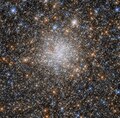Bestand:NGC1898 - HST - Potw1840a.tiff

Afmetingen van deze voorvertoning van het type JPG van dit TIF-bestand: 610 × 600 pixels Andere resoluties: 244 × 240 pixels | 488 × 480 pixels | 781 × 768 pixels | 1.041 × 1.024 pixels | 2.082 × 2.048 pixels | 2.913 × 2.865 pixels.
Oorspronkelijk bestand (2.913 × 2.865 pixels, bestandsgrootte: 21,67 MB, MIME-type: image/tiff)
Bestandsgeschiedenis
Klik op een datum/tijd om het bestand te zien zoals het destijds was.
| Datum/tijd | Miniatuur | Afmetingen | Gebruiker | Opmerking | |
|---|---|---|---|---|---|
| huidige versie | 1 okt 2018 07:31 |  | 2.913 × 2.865 (21,67 MB) | Fabian RRRR | == {{int:filedesc}} == {{Information |description={{en|1='''Celestial fairy lights Celestial fairy lights This glittering ball of stars is the globular cluster NGC 1898, which lies towards the centre of the Large Magellanic Cloud — one of our closest cosmic neighbours. The Large Magellanic Cloud is a dwarf galaxy that hosts an extremely rich population of star clusters, making it an ideal laboratory for investigating star formation. Discovered in November 1834 by British astronomer John Her... |
Bestandsgebruik
Dit bestand wordt op de volgende pagina gebruikt:
Globaal bestandsgebruik
De volgende andere wiki's gebruiken dit bestand:
- Gebruikt op ar.wikipedia.org
- Gebruikt op az.wikipedia.org
- Gebruikt op be.wikipedia.org
- Gebruikt op bs.wikipedia.org
- Gebruikt op ce.wikipedia.org
- Gebruikt op de.wikipedia.org
- Gebruikt op diq.wikipedia.org
- Gebruikt op el.wikipedia.org
- Gebruikt op en.wikipedia.org
- Gebruikt op eo.wikipedia.org
- Gebruikt op eu.wikipedia.org
- Gebruikt op fr.wikipedia.org
- Gebruikt op hr.wikipedia.org
- Gebruikt op kk.wikipedia.org
- Gebruikt op mk.wikipedia.org
- Gebruikt op pl.wikipedia.org
- Gebruikt op pt.wikipedia.org
- Gebruikt op ru.wikipedia.org
- Gebruikt op sh.wikipedia.org
- Gebruikt op sk.wikipedia.org
- Gebruikt op sr.wikipedia.org
- Gebruikt op tr.wikipedia.org
- Gebruikt op tt.wikipedia.org
- Gebruikt op uk.wikipedia.org
- Gebruikt op uz.wikipedia.org
- Gebruikt op www.wikidata.org
- Gebruikt op zh.wikipedia.org

